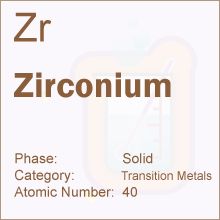 Periodic Table -> Zirconium
Periodic Table -> ZirconiumZirconium
Zirconium DetailsZirconium Symbol: Zr
Zirconium Atomic Number: 40
Zirconium Atomic Weight: 91.22
What is Zirconium?
Zirconium (atomic number 40, symbol Zr) is a transition metal that was first isolated in 1824 by Jons Berzelius. This chemical element was discovered in 1789 by the German chemist Martin Klaproth who also discovered cerium and uranium.
Properties and Isotopes
This element is a metal with a hexagonal close-packed structure and shares properties with titanium. It is lustrous, ductile, malleable, and silvery-gray in color. It is a strong metal that is corrosion and heat resistant. Zirconium has a boiling point of 7952 F (4400 C) and melting point of 3365 F (1852 C). Four stable isotopes are included in the composition of zirconium – Zr-94, Zr-92, Zr-91, and Zr-90. There are also metastable isomers such as Zr-91m, Ze-90m2, Zr-90m1, and others. The element does not react with alkalis and acids but forms compounds such as carbides, nitrides, oxides, and others. Common oxidation states include 1, 4, 2, and 3.
Occurrence
The element is found in different countries, including the U.S., South Africa, Russia, India, Brazil, and Australia. The major deposits are found in South Africa and Australia. There are significant deposits of zirconia and zircon in Sri Lanka, India, the U.S, and other countries. The metal occurs in many minerals, including kosnarite, baddeleyite, and others. Baddeleyite deposits are found in Brazil. Zirconium is also isolated from minerals such as rutile and ilmenite. The total reserves are estimated at over 1 billion tonnes.
Applications
Zirconium has different applications and is added to furnace bricks, percussion caps, and catalytic converters. There are other applications of zirconium and its compounds.

The element is used in TVs, surgical instruments, and flashbulbs in photography. It is used in jewelry, ceramic opacification, and refractories. Zirconium dioxide or cubic zirconia is widely used as a low-cost alternative to gemstones, including diamonds. The metal is also used in the aeronautic and space industries while compounds containing yttria and zirconia are used to make gas turbines, vanes and blades, and combustors. Alloys are also used to manufacture heat exchangers, fittings, pipes, and other components and items. Superconducting magnets also contain zirconium, and it is also used to produce surgical instruments. When alloyed with zinc, it has magnetic properties. The element has applications in the packaging industry because it is strong and water-resistant. Zirconium-based catalysts have applications in different reactions, including oxidation, isomerization, hydrogenation, and amination.
Environmental Effects and Health Hazards
Zirconium is a fairly common element and is more abundant than lead, zinc, and copper. It is not considered an environmental hazard. Only 30 percent of the plants tested contain zirconium, but aquatic plants absorb it more rapidly. Most compounds are inert and insoluble, but cases of pulmonary granuloma or lung lesions have been reported among zirconium workers. Acute side effects include eye and skin irritations and irritations of the throat, nose, mucous membranes, and the respiratory tract. Chronic exposure may cause dermatitis and pulmonary edema. The respiratory tract is also affected. Persons handling zirconium compounds wear rubber gloves.
You can
link to this page, using the code below:
Periodic Table |
Banks
© ElementsDatabase.com 2015 | Privacy | About | Contact